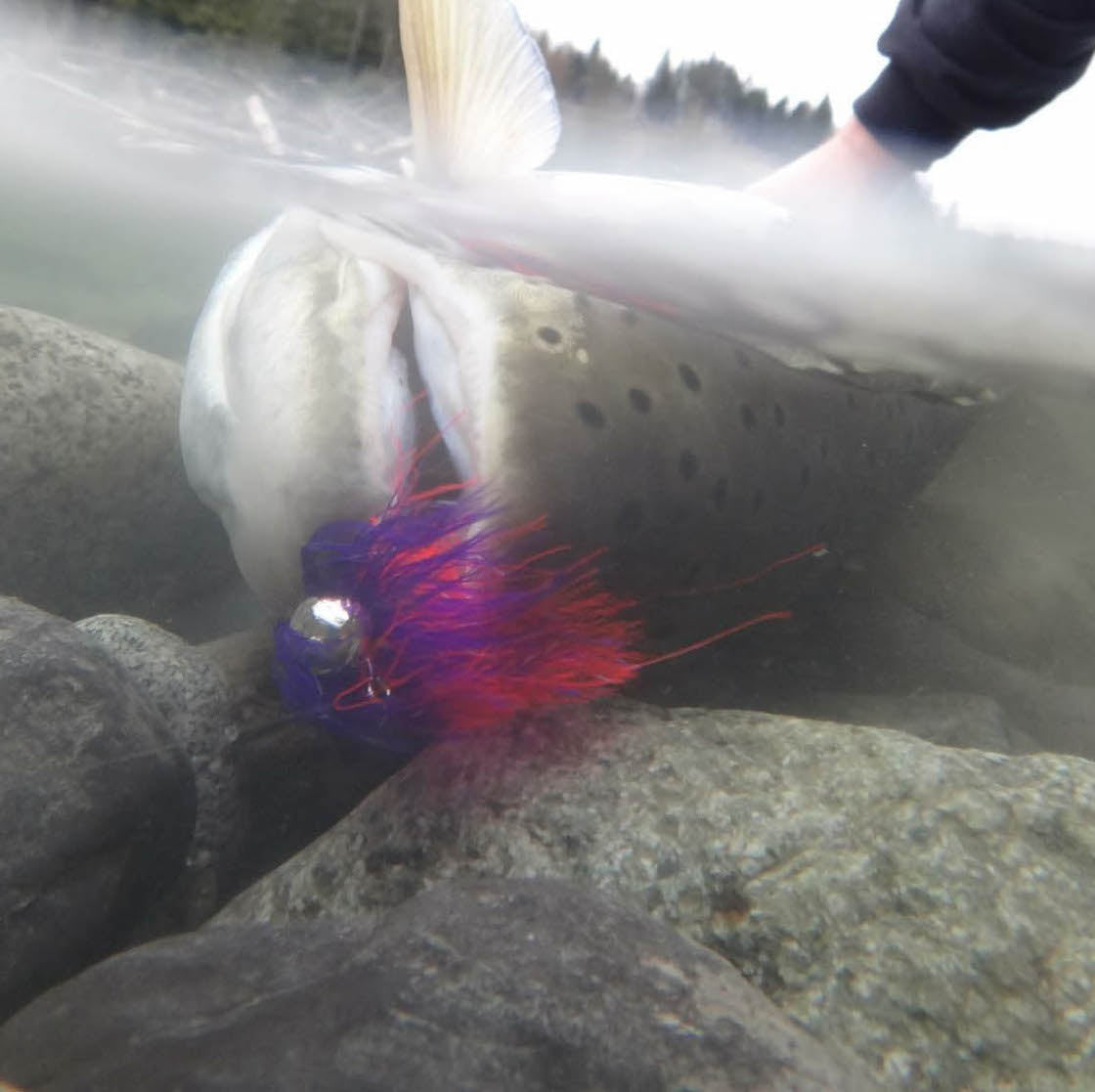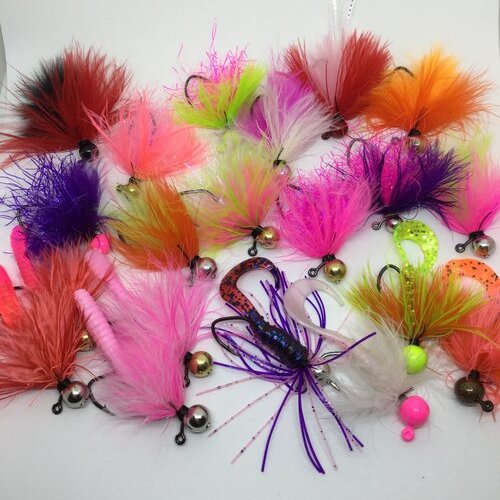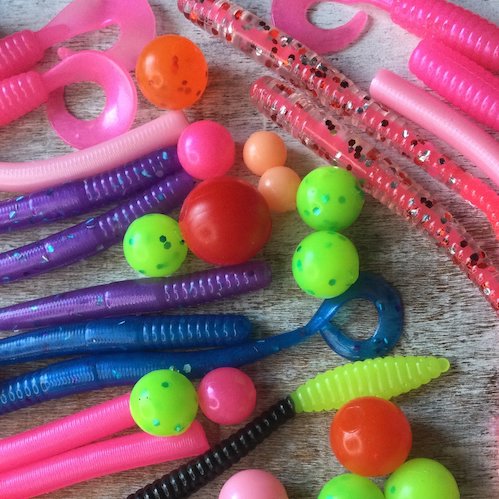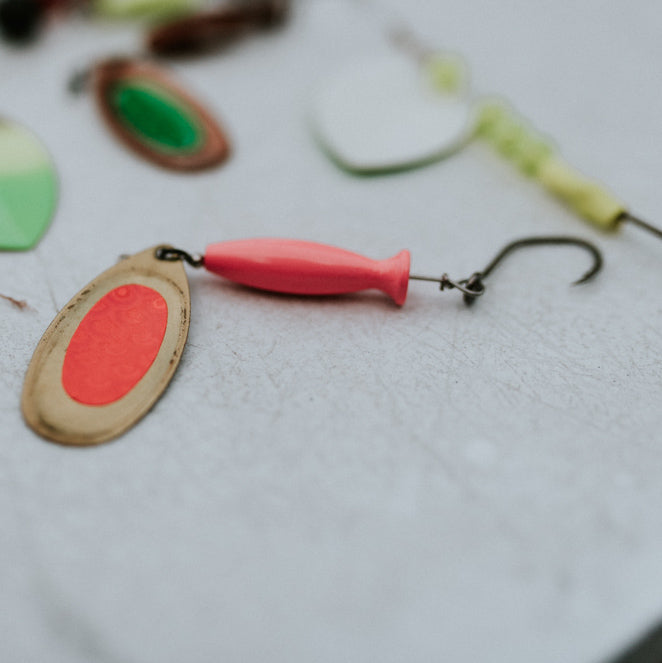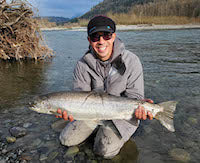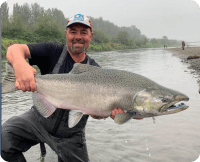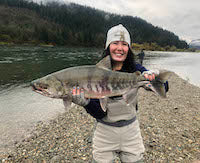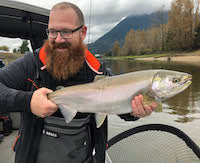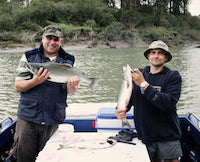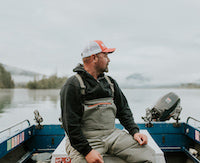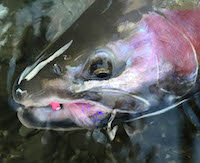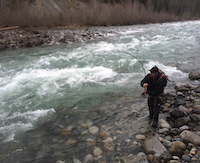In my early years of catching Coho Salmon, the float fishing rod was my tool of choice. While this method can be extremely effective, nothing compares to catching Coho on a light action rod and reel.
As a fishing guide, casting lures with light action rods is by far the most productive method for myself and my clients. While casting lures from a boat is a common method for catching Coho, this same technique when shore fishing can be deadly effective.
RODS AND REELS
There are various rods and reels available to the fisherman wanting to target Coho with lighter tackle. The rods I typically use for throwing spinners and spoons are an 8’6” medium strength rod with a medium action. This spinning rod matched with a spinning reel that will hold at least 150 yards of 20 lb. braided line, is the perfect set up for casting spinners and spoons.
While some anglers prefer a bait cast reel, my strong preference is a spinning reel for light action casting. Particularly for twitching jigs, I like the spinning reel, paired with a 7-7.5 foot spinning rod in medium strength, fast action. The fast action rod is essential for comfortable jig twitching, to combat arm and wrist fatigue.
One or both of these set ups is all you need for targeting Coho with light tackle. Since I so frequently twitch jigs, I typically use just the 7.5’ set up. I use the same reel for twitching as I do for lure casting. My favorite reels are Shimano models in the 3000 size. In my experience, the more you spend on your reel, the better its quality.

Now, let’s talk lures.
My favored lures for light action Coho fishing are twitching jigs, spinners, and spoons- in that order. With all of these techniques, you can guide your colour choices with the formula;
Clear water: reach for dark coloured lures such as purple, black, blue, red, browns and coppers
Murky/Coloured water: reach for brighter colours such as chartreuse, pink, orange, white
JIGS (TWITCHING SIZE & STYLE)
Twitching jigs is a technique that requires a lot of practice, but once mastered, it becomes the method of choice for many anglers. Armed with a variety of jigs in 3/8 oz and 1/2 oz sizes, an angler can easily experience days of constant action using this technique. To learn more about this technique, I encourage you to watch my video “How to Twitch Jigs for Coho” (found on YouTube and our website).
Some key points to remember when twitching jigs for Coho;
- Use 20 lb or lighter, braided mainline
- Use a spinning reel that has at least 150 yards of 20 lb line capacity
- Fast action rods are best
- Vary your twitching style to see what the fish are most responsive to (it can change from day to day)
- Match your jig colour to the water conditions. In the clear waters I fish, I mainly use dark coloured jigs.
- Use your wrist to twitch- not your body or full arms. Your arms will appreciate this the next day.
- You can fish all waters with the twitching technique; it is not just for slow and slack water.
SPINNERS
I could write a lengthy book on fishing spinners, but I will keep it very simple here.
The spinners I use are sized 4, 4.5, or 5 french blade with a weighted body. On our website we name/categorize them as “Weighted Spinners” (not to be confused with our Cascade and Colorado spinners). Many colours and styles of spinners will work.
A coloured body with a metallic blade is my preferred combo. Remember, I could write a book on this subject, so I am not covering all of the ways in which you can diversify your colour combinations. For this article we will leave out the detail of sticker tape colours.
Three popular blade finishes are copper, brass, and silver.
Clear water: reach for copper and brass
Murky/Coloured water: reach for silver and brass
Remember to adjust your colour choices to the conditions. I personally always keep a supply of copper, chartreuse, orange, pink, blue, and red bodied spinners.
When casting spinners, you can target any water that fish hold in. As with twitching jigs, many people tend to target only the slow or slack water. Some of my best days of spinner fishing have resulted from casting across swift tail outs and letting my spinner swing across, while only reeling just enough to keep the blade spinning. Hold on tight in this scenario, as the bites can be ferocious!
SPOONS
Spoons are a very simple and effective lure for light action Coho fishing. As with weighted spinners, copper, brass, and silver are three popular and productive metal finishes. Sometimes, adding a bit of coloured or metallic reflective tape proves effective.
My preferred sizes are 3/8 oz, 1/2 oz, and 5/8 oz spoons.
An important component to remember when purchasing spoons, is the hook quality. Try to purchase spoons with a quality hook, but in a pinch, you can always change up the hook on your spoon. I have done this many times, removing the cheap factory hook, and replacing it with a better quality #1 or 1/o Matzuo sickle hook.

There are various styles of spoon fishing, and your choice of which to employ will depend on the waters you are fishing.
In slow or slack water, cast beyond the suspected fish holding spot and retrieve your spoon just fast enough to keep it off bottom and wobbling.
In runs with fast water, try casting across and allowing the spoon to swing across the run. I reel minimally in this scenario, only enough to keep the spoon from hitting bottom, and to keep it wobbling.
Another action style you can use with spoon fishing, is “jigging” your spoon. This is essentially the same action as twitching a jig. While we could call it twitching, people were likely jigging spoons before twitching jigs, so we’ll stick with that terminology.
When I jig a spoon, I am trying to get the spoon to rise quickly, and then fall in a fluttering motion.
I have experienced terrific days of fishing when jigging spoons, watching chrome Coho Salmon fighting over the fluttering spoon.
I encourage anglers to leave your float fishing rod at home, and arm yourself with nothing more than a spinning rod and reel combo and a box of jigs, spinners and spoons.
On top of being a really fun way to target the Coho, it carries the perk of requiring little tackle… leaving lots of room in your backpack to carry out a limit of chrome, tasty Coho Salmon!



